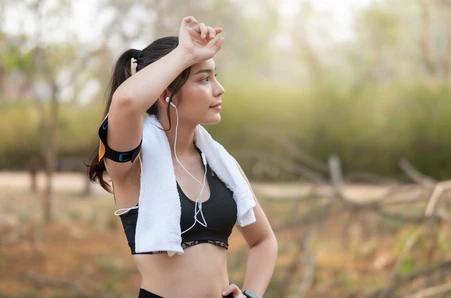Exercising in the summer heat can be challenging and poses risks such as overheating and heat-related illnesses. Here are some effective strategies to keep cool and stay safe during summer workouts:
Understanding Overheating
What is Overheating?
Overheating occurs when your body temperature rises above normal levels, which can lead to heat exhaustion or heat stroke. Symptoms include:
- Excessive Sweating
- Dizziness
- Nausea
- Rapid Heartbeat
- Muscle Cramps
Risks of Overheating
- Heat Exhaustion: Characterized by heavy sweating, weakness, and dizziness.
- Heat Stroke: A severe condition where the body fails to regulate its temperature, leading to potential organ damage.
Tips for Avoiding Overheating
Choose the Right Time
- Early Morning or Late Evening: Exercise during cooler parts of the day to avoid peak heat.
- Check the Weather: Avoid workouts during high heat and humidity.
Wear Appropriate Clothing
- Lightweight and Breathable Fabrics: Choose moisture-wicking materials that keep you cool and dry.
- Light-Coloured Clothing: Reflects sunlight and reduces heat absorption.
- Wide-Brimmed Hat and Sunglasses: Protects your face and eyes from direct sunlight.
Stay Hydrated
- Drink Plenty of Water: Hydrate before, during, and after workouts.
- Electrolyte Drinks: Consider sports drinks to replenish lost electrolytes.
- Avoid Caffeine and Alcohol: These can contribute to dehydration.
Use Cooling Techniques
- Cool Showers: Take a cool shower before and after workouts to lower body temperature.
- Wet Towels and Ice Packs: Apply to pulse points like wrists, neck, and temples.
- Cooling Vests: Wear a cooling vest to help maintain a lower body temperature.
Adjust Workout Intensity
- Lower Intensity: Opt for less strenuous exercises during extreme heat.
- Take Breaks: Rest frequently to prevent overheating.
- Listen to Your Body: Stop exercising if you feel dizzy, nauseous, or overly fatigued.
Safe Workout Locations
Indoor Workouts
- Air-Conditioned Gyms: Exercise in a controlled, cool environment.
- Home Workouts: Use fans or air conditioning to stay cool while exercising at home.
Outdoor Workouts
- Shaded Areas: Find parks or trails with plenty of shade.
- Water Activities: Swimming or water aerobics can be great alternatives.
Alternatives to High-Heat Workouts
- Yoga and Stretching: Low-intensity activities that can be done indoors.
- Strength Training: Focus on indoor resistance exercises.
Recognising Heat-Related Illnesses
Heat Exhaustion Symptoms
- Heavy Sweating
- Pale, Clammy Skin
- Weakness and Fatigue
- Nausea or Vomiting
Heat Stroke Symptoms
- High Body Temperature (above 104°F/40°C)
- Confusion or Agitation
- Rapid Pulse
- Loss of Consciousness
Immediate Actions
- Move to a Cool Area: Get out of the heat and into a cooler environment.
- Hydrate: Drink water or an electrolyte solution.
- Cool Down: Use wet towels, ice packs, or take a cool shower.
- Seek Medical Attention: For severe symptoms, seek emergency medical help immediately.
Summary Table
| Strategy | Description |
|---|---|
| Choose the Right Time | Exercise in the early morning or late evening to avoid peak heat. |
| Wear Appropriate Clothing | Use lightweight, breathable fabrics and light-coloured clothing. |
| Stay Hydrated | Drink plenty of water and consider electrolyte drinks. |
| Use Cooling Techniques | Cool showers, wet towels, ice packs, and cooling vests. |
| Adjust Workout Intensity | Lower the intensity and take frequent breaks. |
| Safe Workout Locations | Exercise in air-conditioned gyms or shaded outdoor areas. |
| Recognise Heat Illnesses | Identify and respond to symptoms of heat exhaustion and heat stroke. |
FAQ
How much water should I drink during summer workouts?
Aim to drink at least 8 ounces of water every 20 minutes during exercise. Hydrate before, during, and after your workout.
What are the best types of exercises to do in the summer heat?
Low-intensity activities like yoga, stretching, and swimming are ideal for staying active without overheating.
How can I tell if I’m dehydrated during a workout?
Signs of dehydration include dark urine, dizziness, dry mouth, and excessive thirst. Make sure to hydrate regularly to prevent dehydration.
Is it safe to exercise outdoors when it’s hot?
It can be safe if you take precautions such as exercising during cooler times, wearing appropriate clothing, and staying hydrated. Avoid exercising in extreme heat and humidity.
What should I do if I start feeling overheated during a workout?
Stop exercising immediately, move to a cooler area, hydrate, and use cooling techniques like wet towels or ice packs. Seek medical help if symptoms persist.
Can certain foods help keep me cool during summer workouts?
Yes, consuming water-rich foods like fruits and vegetables can help maintain hydration and provide essential nutrients for summer workouts.
Should I avoid caffeine before exercising in the heat?
Yes, it’s best to avoid caffeine before workouts in the heat as it can contribute to dehydration.

